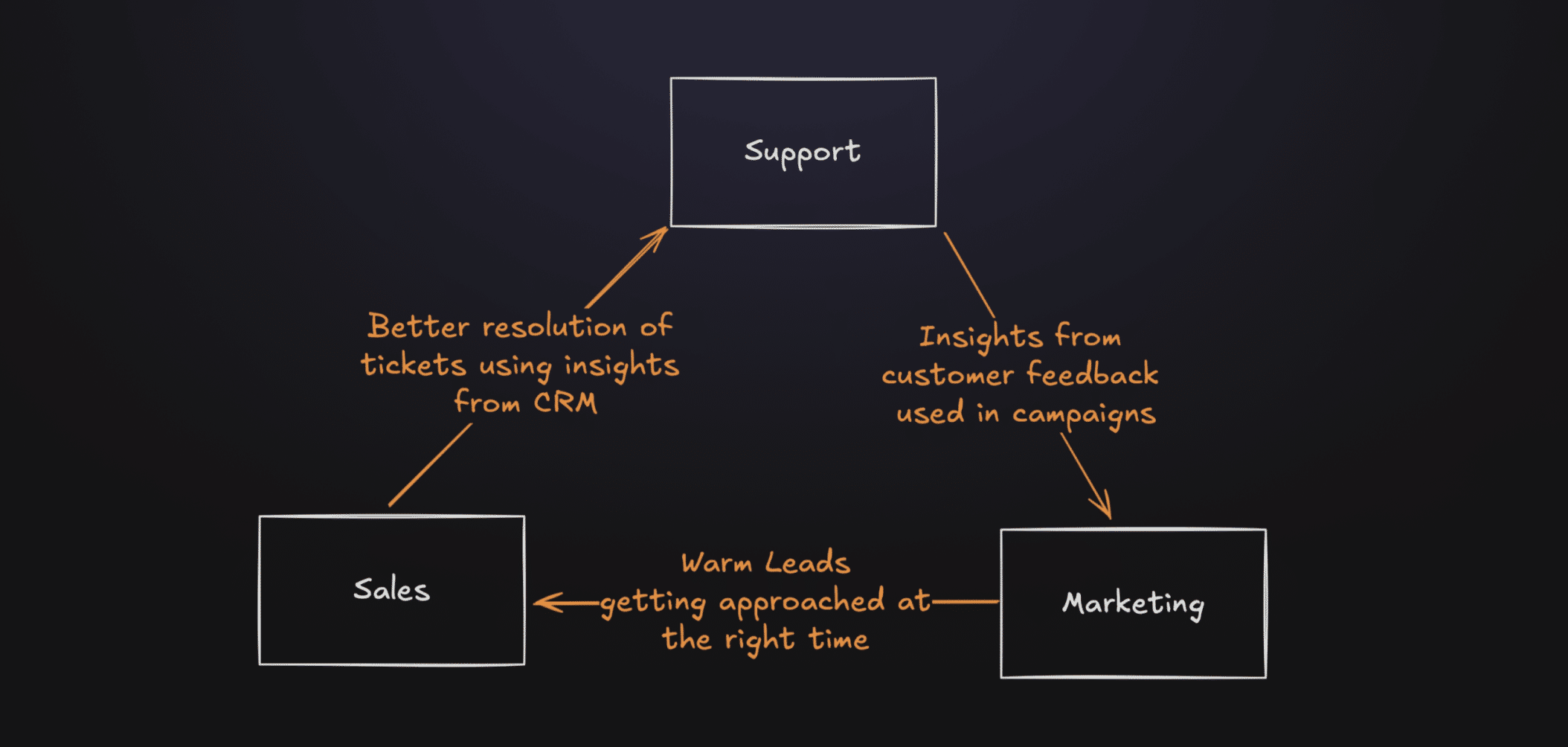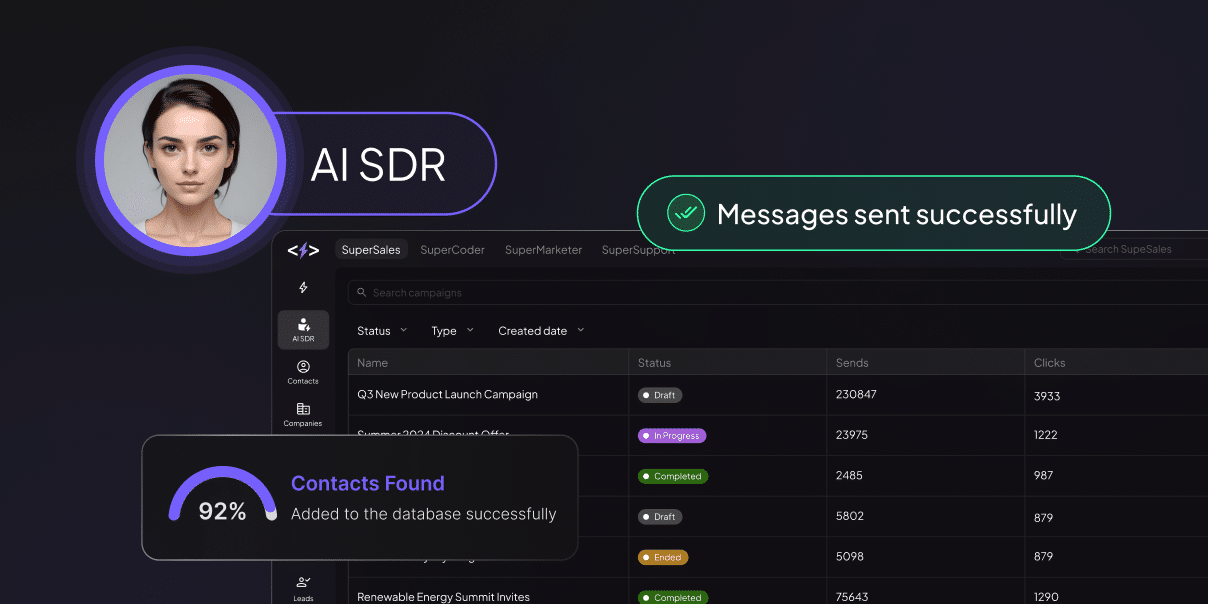Why do AI SDRs make sense today? What changed?
In the sales world, the funnel is shaped like an inverted pyramid – wide at the top, and narrow at the bottom. This means sales teams often spend more time filling the top of the funnel than closing deals. To address this, the industry split the sales role: Sales Development Representatives (SDRs) handle lead generation, while Account Executives (AEs) focus on closing.

SDR work is often seen as more routine compared to AE responsibilities. It’s about quantity over quality. But don’t be fooled – SDR work isn’t easy. If it were, AI would’ve taken over years ago, just like it did with customer support. The fact that we’re only talking about AI SDRs in 2024 shows how complex the job really is. But in 2024, AI has finally caught up.
So why consider AI SDRs now? Here’s why it makes sense:
- Quality at Scale: AI SDRs can dig deep, scanning countless sources to build comprehensive profiles of contacts and companies. They don’t get tired, they don’t overlook details. Human error? Not applicable.
- Scalability: Need to ramp up? Slow down? With AI SDRs, you can adjust your team size instantly, without limits.
- Cost-Effective: Let’s be real – AI SDRs cost less than human employees.
- Always-On: AI doesn’t sleep. It doesn’t take breaks. Need something done at 3 AM? Your AI SDR is on it.
Endless possibilities unlocked with AI SDRs
AI SDRs are revolutionizing the sales process. Here’s how they’re changing the game:
- Smart Prospecting: AI pinpoints leads that fit your ideal customer profile like a pro.
- Deep-Dive Research: Say goodbye to manual digging. AI sifts through mountains of data, serving up structured insights to your team.
- Tailor-Made Outreach: Every lead gets a personalized email crafted by AI, based on in-depth research.
- Persistent Follow-ups: AI keeps the conversation going with automated email sequences until you get a response.
- Handling Objections: AI drafts replies and tackles customer questions, keeping leads warm.
- Custom Sales Materials: AI segments your audience and whips up targeted content for different buyer types – even client-specific collateral.
- Always-On Inbound Support: Imagine a dedicated agent for every website visitor, asking the right questions and guiding them to the next step, like booking a demo.
- Seamless Scheduling: AI books demos across platforms – website, Slack, email, you name it.
- Smart Note-Taking: AI listens in on sales calls, summarizing key points and creating to-do lists for AEs, all synced to your CRM.
- AI-Powered Calling: Generate unique call scripts for each prospect, and even leave voicemails that sound just like your reps.
- Live Sales Copilot: AI SDR can actively listen to your calls and suggest relevant actions which it can perform at the click of a button.
- Proactive Task Creation: AI monitors your CRM, suggesting and assigning relevant actions to both AI and human team members.
- Prioritize your tasks: AI SDR can understand the significance of every deal and its closing probability, and use it to prioritize your action items for you.
- Identifying upsell & cross-sell opportunities: Based on market research AI SDR can predict which existing customer is ready for an upsell or cross-sell.
This isn’t just automation – it’s augmentation. AI SDRs are redefining what’s possible in sales, freeing up your human talent to focus on what they do best: building relationships and closing deals.
AI SDRs will give rise to more dynamic organizations
Fluid GTM Strategies
Today, companies usually decide where to focus resources based on target segments and annual contract value ranges, such as a top-down sales approach or an inside sales-assist approach. They often hire and build teams around a set strategy. These economic assumptions will look very different with AI-SDRs. Companies may be able to reorient their resource allocation based on what’s best for the customer. For example, to close an account, what’s the best go-to-market approach? Currently, many companies choose to identify themselves as either enterprise-grade or developer-first. In the future, companies should be able to cater to both buyer personas with highly customized sales journeys which will be orchestrated by AI-SDRs.
Team-based incentives
As AI-powered Sales Development Representatives (SDRs) take over most lead sourcing and outreach, the old fights over who gets credit for bringing in a lead will become a thing of the past. Even inbound leads will first go through an AI-SDR, which will qualify them and then assign them to the most suitable Account Executive (AE) based on their availability and expertise.
We’ll also see the rise of AI-powered Live Sales Assistants, helping every AE reach their full potential. This shift will make sales less hectic and cutthroat, potentially making the profession more appealing to a wider range of people who might have been put off by its traditionally competitive nature.
Unification of platforms
Currently, companies often use separate tools for sales, retention marketing, and customer support. These siloed systems don’t communicate well, leading to fragmented information. While this isn’t a major issue now – since humans operating these tools can piece together the full context – it will become problematic as we move towards AI-driven platforms.
As AI takes on more decision-making roles, the benefits of merging the tech stack for sales, marketing, and support will become clear. An integrated system will allow AI to access comprehensive customer data, leading to more informed and effective interactions across all customer-facing departments.

Considerations while selecting the right AI SDR offering:
- Deep CRM integrations: AI SDRs typically own the data even before it enters the CRM. They operate at the upstream end of the workflow, making it easy for customers to plug AI SDRs into their existing CRM. As the benefits of AI SDRs have become evident, customers are now interested in exploring them in downstream parts of the workflow. However, AI SDRs designed for peripheral operations lack the capabilities to perform downstream tasks, as they require context from the CRM. The next generation of AI SDRs, such as SuperSales from SuperAGI, addresses this issue by providing in-built CRM functionality, enabling AI SDRs to have deep and meaningful interactions with the CRM.
- Full stack coverage: Beyond CRMs, there are other existing tools that can enhance the capabilities of AI SDRs. For instance, if an AI SDR can respond to inbound emails, it can also manage incoming chats displayed on your website’s widget. Another example is integration with an Enterprise Data Source. To generate more leads, simply specify the Ideal Customer Profile (ICP) to your AI SDR, and it will automatically fetch relevant leads from the data source. Another crucial integration is a content library. AI SDRs can generate hyper-personalized sales collateral if they have access to a basic content library.
- Email infrastructure: While AI SDRs are designed to perform personalized outreach at scale, sending mass emails involves more than just personalizing content. It also requires orchestrating the email infrastructure to maximize deliverability. Ensuring that domain health is not compromised is crucial because otherwise, even with advanced hyper-personalization capabilities, leads will be lost, and you won’t know which emails went to spam. Even if you switch back to manual prospecting, emails will still land in spam, which is the worst part. Therefore, you should opt for sophisticated AI SDR solutions that enable you to send mass campaigns from multiple domains, protecting your primary domain’s health.
- Intelligent user interface: As AI SDRs increasingly take on more functions, they can now translate complex instructions into appropriate actions. This means that a complex UI is no longer necessary. This flexibility allows business applications to expand their reach beyond desktops. You can now complete tasks on your mobile device, even with limited screen real estate. It’s time for consumers to demand more – multi-platform support, which is particularly useful when people involved in field sales.
What’s next for AI SDRs?
Till now AI SDRs, are mainly seen as a smart colleague who can execute some of the tiresome workflows for you without getting tired. But very soon, we will get AI SDRs who can also act as smart managers who will help you identify and prioritize your actions – ensuring that you never miss a single opportunity.
AI SDRs of today are the dumbest AI SDRs that you’ll ever use. They are only going to get smarter with time. They’ll be able to understand the custom best practices which you follow in your organization, and adapt accordingly. As they become more intelligent, they may even suggest some modifications to these best practices. This is just the beginning…







